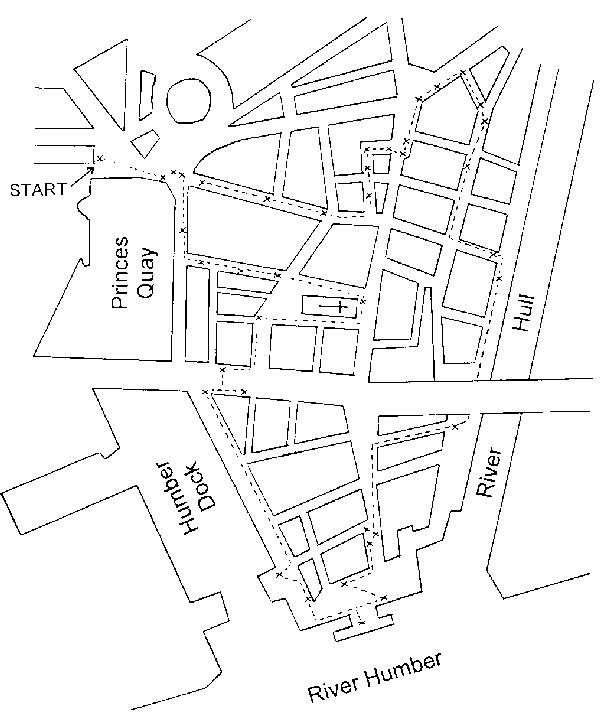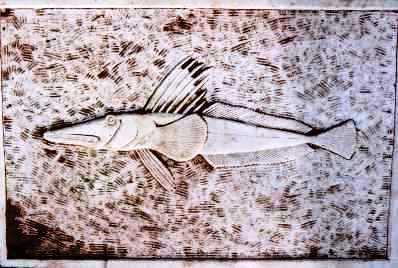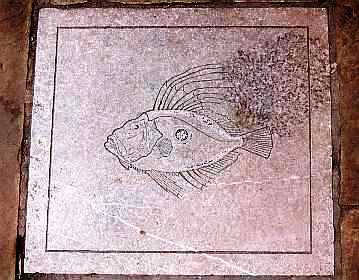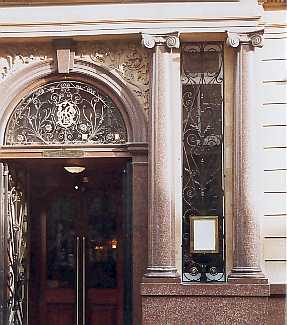

Humberside Geologist No. 12
The Geology of the Hull Fish Trail
by Mike Horne
[ Editor's note - since this was published in 1999 some of the fish have been moved and premises may have changed their names and use.]
In 1992 the Hull City Council created a fish Pavement trail through the 'Old Town' of Hull, sponsored by Seven Seas. It consists of sculptures or engravings of fish (and some invertebrates) representing all the letters of the alphabet. Most of these are of geological interest, either being carved in stone, set into stone or made of man-made geological materials, such as glass, brick, steel and other metals. Here is a description of the rock types you will find if you follow the trail. Please be aware that the names of the shops mentioned in the text may change and one 'pelican crossing' has moved since the original trail was created. It is quite a long walk, but you can do it in bits, or take a break in some of the pubs on the way.

Because we cannot hammer or test the rocks and can only go on their appearance, the descriptions and geological names given may not be 100 per cent accurate. Please do not damage the rocks.
The trail starts at the Tourist Information Office in Queen Victoria Square, with the first fish of the alphabet - a shoal of 46 chromed bronze anchovies, set into sandstone paving stones.
Near the entrance to Princes Quay are 8 lobsters, cut into Cornish slate. When the trail was created there was a children's' bookshop there and it was a reference to the Lobster Quadrille in Alice in Wonderland. The pillars of the shop are lovely pieces of granite with xenoliths. At Beverley Gate there is a cod, made of chromed bronze set into white Carrara Marble (a metamorphosed limestone) from Italy. The medieval bricks of Beverley Gate were probably made locally from clay dug out of the moat that surrounded the town. Nearby is a shoal of tiny x-ray fish etched into a piece of glass, which was originally (and may still be) lit from beneath at night.
In Princes Dock Street there are two flying fish in new "York Stone" panels on the front of the Sailors Families Society and one on an old paving stone beside the drain pipe. A line of red herrings in red brick leads the way through Posterngate, which has red and ,grey granite cobblestones. Kippers are depicted on the wrought iron side gate to number 8 Posterngate and beside this erratic blocks are used as cobbles in the courtyard.
In Market Square there are four plaice in sandstone pavers which are found on the street corners. Holy Trinity Church dominates the area and is made of brick and Magnesian Limestone from West Yorkshire and in places is patched up badly with Ancaster Stone from Lincolnshire. A wide variety of rocks can be seen used as gravestones, now laid flat, in the churchyard. A shoal of mackerel can be found carved into the old grey/brown sandstone paving stones of the old Market Place, at the eastern end of Holy Trinity Church (not the area of the present market).
On one side of Castle Street you can see a catfish chasing a dogfish, made of lead set into Elland Flag sandstone. Nearby, a wide variety of local glacial erratic pebbles have been set in concrete beside the pavement. On the opposite side of the road (outside 8 Marina Court) is a swordfish carved into Cornish grey slate. [note: the road crossing was moved after the trail was created, so you will have to take a slight detour to find the swordfish]. On the corner with Humber Dock Street is a boulder of pink shelly limestone with a starfish, a mussel, some seaweed and a warty doris mollusc carved on it. The boulder is a nodular Jurassic limestone, containing oysters, a belemnite and other shells.
In Minerva Terrace is a circular piece of pale grey Hopton Wood stone with a quid, viviparous blenny and yarling carved into it. In the pavement at the side of the Minerva Hotel there is a haddock carved into black Belgian Carboniferous Limestone with fossil crinoids. This has the words "blistering barnacles" carved into it; which is a reference to Captain Haddock from the Belgian cartoon Tin Tin. In front of the Minerva pub is the "tide turning" sculpture made of slabs of dark grey slate.
The umbers burnt into the decking of Victoria Pier are the only fish without geological interest, but nearby in Nelson Street is a large ray carved into blue bricks from Staffordshire and on the raised area near the pier is a turbot carved into polished and etched grey granite.
Pilot fish are carved into Elland Flags outside the Pilot Office and Oberon pub in Queen Street. Outside 4-15 Nelson Court, near the corner with Wellington Street, a Garfish is carved into green Tilberthwaite Tuff from the Lake District. This fascinating rock is volcanic ash which settled as a sediment in a lake or sea, (this example shows brecciation implying that the sediment settled partially lithified and was then disturbed), and later the rock became metamorphosed into a slate.

Icefish carved in Carrera Marble.
In Humber Street, beside a big black anchor between the tidal barrier and the Garrison Road bridge, is an icefish carved into Carrara Marble. On the riverside boardwalk eels made of steel are set into the decking and a steel salmon is on the ramp into Scale Lane Staithe, beside some blocks of oolitic limestone. The Staithe is made of granite cobble stones, the edges of which have been worn by the steel tyres of wagons in earlier times.
In High Street you can see a black crab in the pavement at the base of a drainpipe outside the Sailmakers Arms and a bronze shrimp in a pale crinoidal limestone on the left of number 167A High Street opposite Nelson Mandela Gardens. Don't forget to stop at the Hull and East Riding Museum to see the local rocks and fossils on display and the impressive sandstone pillars at the entrance. A shoal of whitebait impressed into Kettley bricks leads round from High Street, through George Yard into Alfred Gelder Street.
A long electric eel is carved into Derbyshire gritstone on the corner of Alfred Gelder Street and a sea trout is carved into old York Stone. The new Court building is made of red granite, buff coloured gritstone (perhaps from Derbyshire) and red brick. On the corner with Lowgate there is a lumpsucker carved into sandstone.

John Dory carved in Orton Scar Limestone
Under the tower of St. Mary's Church the john dory is made of Orton Scar limestone, which has mineral veins (presumably calcite) in it. Beside the bus stop is a brill in sandstone. St. Mary's Church is made of Magnesian Limestone and inside the floor is tiled with red and black Carboniferous Limestone, containing corals.
At the entrance to Exchange Court a gurnard is carved into Lazenby coarse grained red sandstone. Notice how the white Carrara Marble step with lead lettering has been eroded over the years. The squid in Exchange Court Alley is made of cast iron and the long oarfish is carved in Hopton Wood stone. Two hake can be seen in cut steel across the road in White Harte Alley. On the corner of Silver Street and Trinity House Lane you can see that Lloyds Number 1 Cafe Bar

Virgo Granite pillars, Lloyds Number 1 Cafe
(a former bank) is made of deep red 'Vergo' granite from Sweden containing blue strained quartz at its base and Ancaster Stone with its 'streaky bacon' texture above. There are also beautiful turned pillars of the granite.
Turning into Whitefriargate you can find a monkfish in black Belgian Carboniferous Limestone outside Adams. The shop fronts of Whitefriargate incorporate a wide variety of rocks, including red granite and black gabbro at Poundstretcher (formerly Woolworth's), beautiful orbicular "Baltic Brown" granite from Finland at Littlewoods and sparkling "Blue Pearl" Larvikite from Norway at Marks and Spencers. The shark carved into grey Cornish slate has been moved from its original site and is now outside the Midland Bank. It has been cracked and chipped by the weight of lorries driving over it. The zander completes the fish alphabet and is carved in Tilberthwaite Tuff.
Further reading:
Anon 1992. The Fish Pavement [map and guide leaflet]. Hull City Council.
Home M & R Harrison, 1991. A Geological Walk in the City of Hull. Humberside Geologist 8, 21-25.
Horne M, 1995. Geology in the City.
Humberside. Geologist 11, 3-4.
Copyright Hull Geological Society.
Copyright - Hull Geological Society 1999 & 2020
Registered Educational Charity No. 229147